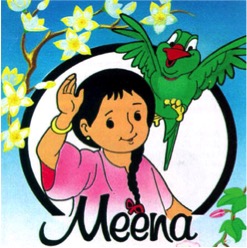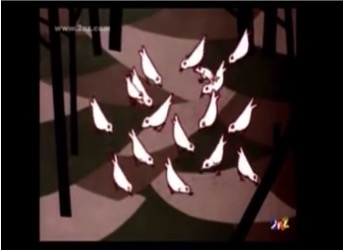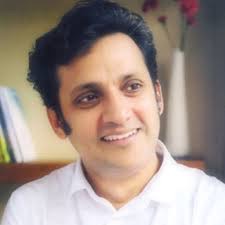While India’s live action movie industry (Bollywood) has enjoyed extreme success and an enormous fan base, Indian animation has struggled to gain a comparatively large following. However, soon after animation was introduced in India, Indian animation tapped the talent pool of its sister film industry Bollywood by recruiting Bollywood musicians to produce the songs in animated films.
Recognising the music in animation as the same as Bollywood music, the Indian public quickly took note of animated films and began to associate them with the entertainment value that Bollywood movies held. It could be argued that music has been the most constant component of Indian animation over time, which has become increasingly diverse in terms of art style, plot, and theme.
From the late 1950s to the 1990s, the pre-eminent Indian animators were Ram Mohan and Bhimsain Khurana, each of whom has been referred to as “The father of Indian Animation”. Ram Mohan was responsible for starting animation in India, while Bhimsain Khurana was the first to capture widespread popularity among Indian audiences, primarily through his musical talent.

In order to take off in the late 1950s, Indian animation required the help of American animator Claire Weeks. With Weeks’ help, Mohan learned cel art animation using hand drawings and a technologically state-of-the-art camera gifted by the US government. After learning the art of animation, Mohan started to work for the Indian government’s Films Division. Initially, his work consisted of short propaganda films explaining the important government agenda and showing the functioning of Indian democracy to the Indian public.
The first non-propaganda studio was The Banyan Deer, which was highly successful, although it is worth noting that the main character greatly resembled Bambi, the deer from Weeks’ American films. Following his government appointment, Mohan began work at Prasad Studios in 1961, which moved to Mumbai just to accommodate him, acknowledging him as a leading animator.
Additionally, Mohan produced his own films including Baap Re Baap, a documentary about family planning, and You Said It – an educational film teaching about the democratic process. He also collaborated outside of India, working with Japanese animators to create the animated series Ramayana in 1992.
Mohan worked for Unicef to create Meena (1995), a 13-episode series dealing with issues concerning a young South Asian girl. Later he became an entrepreneur and a teacher, starting his own computer animation studio as well as an animation school to teach the next generation of Indian animators.
Mohan was acknowledged as an excellent teacher by the other man known as the “Father of Animation,” Bhimsain Khurana. Bhimsain wanted to be a singer, while his father wanted him to draw, so Bhimsain compromised between the two careers by graduating with degrees in both fine arts and classical music.

Bhimsain Khurana was especially notable for his immense musical knowledge, which might be the reason for the huge popularity of his short films on Doordarshan, India’s sole television channel in the 1970s. A generation of Indians grew up humming his music from Ek Anek Aur Ekta. Like Mohan, Bhimsain joined the Films Division of India in 1961, and learned animation directly from Ram Mohan.
After Mohan left the Films Division and went to Prasad Studios, Bhimsain followed him there. Initially, Bhimsain worked as a background artist in both the Films Division and Prasad Studios, but then progressed into a foremost animator, announcing his arrival with his one-minute video Climb, which fetched him the Silver Hugo Award at the Chicago International Films festival in 1972. Winning this award gave him the impetus he needed to start Climb Films studio – his own venture – in 1972.
As mentioned, Bhimsain’s propaganda film about India’s unity in diversity Ek Anek Aur Ekta became the most popular video in the history of Indian animation. This film depicted cut-out animation shots of butterflies against a cel-animation backdrop, illustrating his mastery of various animation techniques. This short film, along with showing authentic Indian designs, characters, culture, and background, uses catchy indigenous Indian music.
Another of Bhimsain’s prominent films was Munni, a short film on family planning that most Indians who were old enough to watch TV in the 1970s can still recite from memory. After making several live-action movies and TV serials, Bhimsain created Lok Gatha (1992), India’s first computer-assisted animation series.

Over his prolific career, he has amassed over 14 national and three international awards, winning acclaim for work spanning some of the earliest Indian animations to his latest 3-D animations. Bhimsain won the Lifetime Achievement award at the Toonz Media’s Animation Masters Summit 2017. During his storied career, one of Bhimsain’s notable collaborations came in 1994, when he created the 26-episode series Vartaman in partnership with his son, Kireet.
Although there are several up-and-coming young Indian animators today, Bhimsain’s son Kireet is an especially notable young animator, as he has been instrumental in preserving Indian animation’s distinctly Indian quality, while receiving a Western education from the best animation school in the world. Kireet possessed several characteristics ideal for an animator: he grew up learning from Bhimsain at a time when Indian animation was a scarce commodity, he loved to draw from an early age, and he had a self-professed shy and reserved nature.

Kireet trained in the West, obtaining an excellent animation education from Canada’s Sheridan College. Despite travelling to the West, he did not model his films after Disney or other distinguished Western animation studios, keeping an indigenously Indian quality in his films by depicting distinctly Indian languages, mannerisms, culture, and backdrops. Moreover, unlike a great deal of Western animation (particularly animation targeted to younger audiences), Kireet’s animations communicate important messages about Indian society, in addition to providing high entertainment value.
(Dartmouth College’s Biomedical Engineering Sciences student Kevin Kang has composed the following article centering on the life and work of Kireet Khurana, a small part of his research work on the Indian animator.)
Also read, Origins of Indian animation: The tribulations and enduring consciousness of Kireet Khurana

